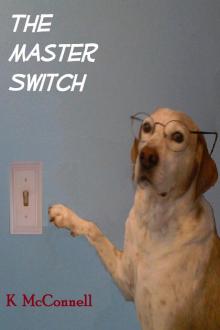- Home
- K McConnell
The Master Switch Page 2
The Master Switch Read online
Page 2
to sort this matrix down to that level. It’s a 3 dimensional matrix of varying densities and non-uniform shapes which makes individual data points extremely complicated to sort out. We can, though, store the entire personality “cloud”, a p-cloud we call it, in a data set occupying approximately 3 terabytes.”
“You can store the mind of a dog into long term digital memory?”
Haverton nodded.
Jason thought for a moment. “So…have you been able to do anything with the data as yet?”
Haverton smiled. “Yes. Would you like to see?”
“Absolutely.”
Haverton stood up and Jason followed him out of the room. They walked down the hall turned twice and came to a door with a digital lock. Haverton punched in some numbers and pushed on through. It led to a set of stairs leading down to the basement of the facility. They walked between long rows of stacked empty cages.
“All empty.” Jason commented.
“Yes. That’s where the dogs originally were.” Haverton said over his shoulder as he walked on.
Jason was about to ask what happened to them all when they entered a room at the end of the cages. In the center of the room stood a steel table. Around it were several utility carts on wheels holding a variety of medical and electronic instruments. On one cart sat a computer. Out of the back of the computer a couple of cables emerged at the end of which were two long, very thin needles.
“It’s through these,” Haverton pointed to the thin needles, “which are inserted into the brain itself that the software maps out the mind. The software stimulates various parts of the brain and translates the responses into data sets, based on the area of the brain and the type and amplitude of the electrical stimulus.”
“And that creates the 3D map?” Jason asked.
Haverton nodded. “The process itself can take up to 12 hours to complete. Also,” Haverton paused, as if remembering something, “the stress of the process causes some degree of pain to the subject.”
“So how many dogs have you processed to this point?” Jason slowly circled the table.
“All of them. That’s 27.”
“It would seem then that you should be ready to move on to primates.” It seemed odd to Jason that, given their success, they would not already have moved on.
Haverton glanced over at Jason with a strange look of surprise. Haverton shook his head. “No. We need to bring in more dogs.”
Jason’s face wrinkled. “Dogs? Surely you have sufficiently demonstrated adequate success with that species. It would seem logical to move further up to the monkeys.”
Haverton shook his head as if he was admonishing a student. “No. Dogs are the only reasonable species to work with.”
Jason was about to question this when the door burst open and a young woman stood in the threshold. She seemed frazzled as she pawed at her clothes.
“This won’t work for me.”
Haverton sighed. “You’ll just have to make due. Now leave us.”
“I can’t…” She tugged at the skirt. “It’s not right.”
Haverton’s voice turned hard. “Go! Go on! Go!”
The woman scampered away.
“I’m sorry.” Haverton said. “She’s kind of new and hasn’t adjusted yet.”
Jason stared at the door for a minute, puzzled. He was about to ask more about the woman and changed his mind. “Where are all the dogs you used in the testing?”
Haverton shook his head sadly. “The first dog successfully mapped died shortly after completion of the mapping process. It wasn’t until the death of the second dog it was discovered that the mapping process ultimately and permanently disrupts the autonomic center of the brain for reasons as yet unknown. Without a functioning autonomic center, of course, both heart and lung function fail.”
“I see. So all of the dogs are dead?” Jason asked.
Two technicians appeared in the doorway and, following a nod from Haverton, began tinkering with various pieces of equipment in the room.
“Yes. Well, sort of. We have all of their matrices stored on the network.” Haverton patted a computer station next to him.
“Yes, but that’s just data.” Jason pointed out. He was though, obviously not greatly concerned about the fate of the dogs. It was the primates that were of importance at this stage anyway.
“Ah, yes, well that brings us to another critical point of interest.” Haverton said with a smile.
“And that is?” Jason asked.
“Well, we discovered, quite by accident actually, that if the process is reversed and the data is fed into a healthy functioning brain the ‘personality’, if you will, can be restored---somewhat, anyway.”
Jason sat, stunned, for a moment. “Are you saying that you can download these brain patterns from one brain and transfer them into another?”
Haverton nodded. “Essentially, yes.”
Jason tried to digest this. “How…what happens with…?”
Haverton gestured instructions to one of the technicians. “Yes, of course, the data can be fed back into the brain at a much higher rate than the mapping process takes, but there is about a 48 hour adjustment period in which the subject must remain in a deep sleep. Presumably this allows the brain to sift and sort through the newly inserted brain pattern so it can be fully assimilated.”
“Assimilated?” Jason was still working through it.
“Yes, well, it’s not as if we can feed the data back into an empty brain now can we? Where would we obtain such a thing? The overlay of the new brain pattern happens fairly quickly, but it seems that full integration requires a little more time. Fascinating, isn’t it?”
“So, you have mapped out a dog’s personality pattern and…put it into another dog’s brain? Did that work?” Jason glanced back towards the hallway full of empty cages. “And where are the dogs? Are they all out in the backyard playing happily?”
Haverton gave a brief chuckle. “We don’t have a backyard.” He nodded to one of the technicians.
Jason felt a poke in his right arm. He tried to jerk around, but found himself held by a technician while the other one was pulling a syringe out of him. “What the…?”
“I haven’t told you about what could be our biggest discovery.” Haverton said. “You see Haverton had an idea after several of the dogs had been mapped out. He thought that it just might be possible to get a glimpse of exactly how a dog sees the world by reversing the feed and sending the image of the dog mapping into his own head. As it turns out the flexibility of the software was only too accommodating.”
“What did you just…?” Jason was pointing at his arm.
“Oh, just a mild sedative. For the stress of all of this.” Haverton said with a smile.
“But I’m not…” Jason started.
“So you see, by reversing the feed from the data stored on the network back into the brain the system quite smoothly writes the same pattern back into the brains synaptic pathways. What was amazing was its tendency to only overwrite patterns of a similar design.” Haverton spoke as he entered something into key fields on the computer screen.
Jason swayed. The two technicians stepped forward and helped him sit back on to the table. “Synaptic patterns…similar design.” He mumbled.
“Yes, the reverse feed tended to avoid overwriting areas where factual, knowledge based information was stored and only seemed to affect those parts of the brain that reflected our ‘personality’ mapping. What that meant was the essence of the dogs that were mapped,” Haverton patted the computer next to him, “could be reinserted into a different brain, any brain, as Haverton inadvertently discovered.”
Jason tried to stare through a growing haze. “Haverton discovered…? But you’re Haverton…” The two technicians eased Jason back on to the table and began strapping him down. He wanted to resist, but found his body reluctant to respond.
“Well, this has been an interesting discussion, but we can’t keep our last remaining friend waiting, now can we?” Again Haver
ton patted the computer.
“Waiting…?” Jason struggled to get the words out.
“Yes. You asked if the dogs were all dead. The answer is: not really. We’re all here. Its Haverton and his colleagues that are gone.” Haverton smiled and tapped his forehead.
With a spark of receding consciousness Jason began to understand. He glanced up at the two technicians. They smiled down at him, nodding. He shot a panicked look over at Haverton and tried to speak, but nothing would come out.
Haverton smiled again and answered Jason’s unspoken question. “Woof. Woof.”
###
Please email the author at: [email protected] with any and all thoughts or comments about this story (or writing, reading good books, the quirky nature of life or anything that comes to mind).
Other books by this author:
To Not Be In Hamlet, Book 1 in the Hamlet Mystery series
The Art of Hamlet, Book 2 in the Hamlet Mystery series
A Conspiracy in Blood, The Hunt for Dr. Oblique
Symbiotic Puppets, Who are we really? Some Scifi fun...
The Plague, Is our true identity buried on Mars?
The Club of the Bombastic Few
Please visit www.HamletMysteries.com for information about this author, a blog on with an odd perspective on life, more other stories from this author, including the Hamlet Mystery series and free fiction to download...

 The Club of the Bombastic Few
The Club of the Bombastic Few The Master Switch
The Master Switch